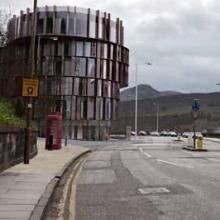
Over 120 opponents of plans to develop the old Royal High School as a luxury hotel met last night in central Edinburgh to discuss progress and ensure timely and relevant objections.
Convened by the Architectural Heritage Society of Scotland, the 'urgent action meeting' comprised speeches from representatives of Edinburgh World Heritage, the Cockburn Association, the AHSS itself, and the Royal High School Preservation Trust.
'Battle for the soul of the city'
Adam Wilkinson, director of EWH, spoke first. He said key to Edinburgh’s ‘outstanding universal value’ was its architectural response to the dramatic rise and fall of its topography. It possesses the largest and finest collection of neo-classical buildings in the world, of which the old Royal High School is a pre-eminent example.
EWH, he said, had been involved with the developers from the start in 2008. It had offered 'clear and consistent advice’ throughout the process of consultative workshops, not least on preserving the building’s carefully contrived setting in the landscape.
Despite this, the height of new buildings envisaged by the developers had steadily risen.
EWH’s advice had been ‘completely ignored’.
Wilkinson recommended objectors should stress that this site was not the only or most desirable location in Edinburgh for a 6-star hotel.
This was not a struggle between Development and Heritage, but between ‘damaging Development and appropriate Development’. We have here, he said, a 'battle for the soul of the city’, and in any appraisal of financial profit against cultural value in this case, it should be remembered that most of the profit would go abroad.
'Inappropriate' design and economic model
Louise Forsyth spoke next for the Cockburn Association. She stressed that the body was not anti-development but pro-high-quality urban design.

In conclusion, she argued that the site was too small for the economic model proposed here. Without wishing to criticise the generally high quality of architect Gareth Hoskins’s work, Thomas Hamilton’s building would be better left empty than encroached upon in so inappropriate a way.
Practical advice

- use both planning application references: 15/03989/FUL and 15/03990/LBC
- address to both planning officers handling the case: Carla Parkes and Euan Mcmeeken at Waverley Court, 4 East Market Street, Edinburgh EH8 8BG
- explicitly use the words ‘I object’
- be rational not emotive
- respond by 2 October.
(Spurtle points out that theis advice applies equally well to those who favour the proposals, except that they should explcitly state 'I support'.)
Graham strongly recommended asking Edinburgh councillors to convey objectors’ concerns to those councillors sitting on the Development Management Subcommittee. She also urged people to write now to MSPs Alex Neil and Fiona Hyslop, asking them to ‘call in’ the case if councillors should later approve it.
A return to education

RHSPT favours building a new foyer to the rear of the Thomas Hamilton building. Muir conceded that AHSS might have reservations about this, but the proposal was not a deal-breaker and could be discussed later and dropped if necessary.
The building, he said, occupied a ‘moral position in the city’ which required a continued public stake in its future.
And finally
In a question-and-answer session afterwards, various points of interest emerged.
- Representations to the Council are permissible from people living outwith Edinburgh and anywhere else in the world, 'even Berwickshire'.
- Objectors were advised to avoid pro forma letters, and not to pick holes in the 'visualisations' which accompany the application – such points too easily come across as professional insults rather than objective clarification.
- The cumulative effect of recent planning decisions on Edinburgh's architectural integrity may be a material objection.
- The audience was reminded that whilst the Council's decision is informed by strict planning criteria, it will be voted upon by politicians. Objectors were advised to remain 'dry and dreary' when detailing objections to officials. But they could by all means express 'feelings' when politely persuading politicians elsewhere.
- The poor condition of the Thomas Hamilton building has allegedly been overstated by the developer. It was strongly constructed of the best materials and is not in imminent danger. RHSPT estimate it would cost £8m–10m to bring back into use (a similar estimate to that of Duddingston House Properties and the Urbanist Group).
- Speakers cautioned against fanciful conspiracy theories and talk of private legal challenges. At this stage, it was more useful to concentrate upon due process and relevant points made in the right way to the right people at the right time.
Got a view? Tell us at spurtle@hotmail.co.uk and @theSpurtle and Facebook
------------------------------------------
 Ross McEwan Campaign needed like Save 1 - 6 Canonmills Bridge real public support not just a couple of hundred
Ross McEwan Campaign needed like Save 1 - 6 Canonmills Bridge real public support not just a couple of hundred
 Jennie Green Agreed. Gemma and Kelman look at this x
Jennie Green Agreed. Gemma and Kelman look at this x
 Nicole Roberts I......think........I quite like the design *hides behind sofa*
Nicole Roberts I......think........I quite like the design *hides behind sofa*